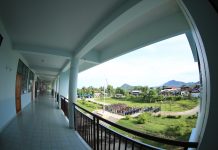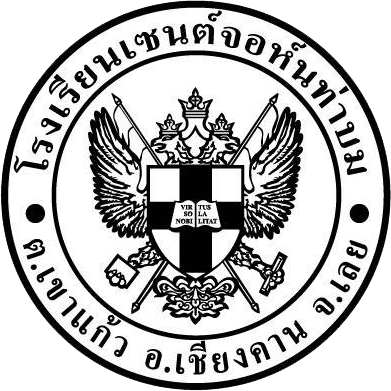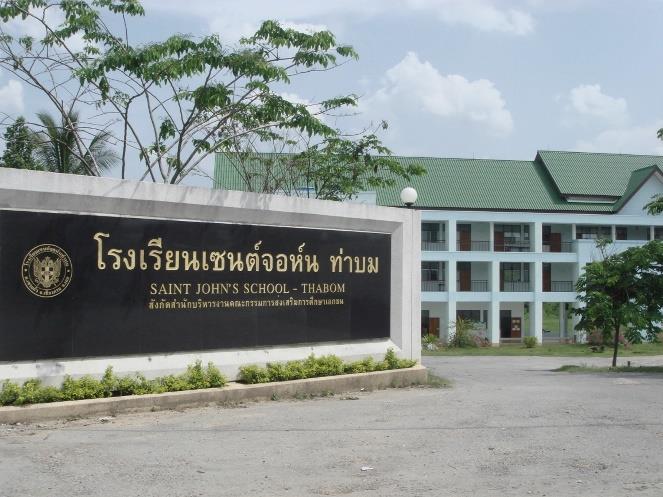
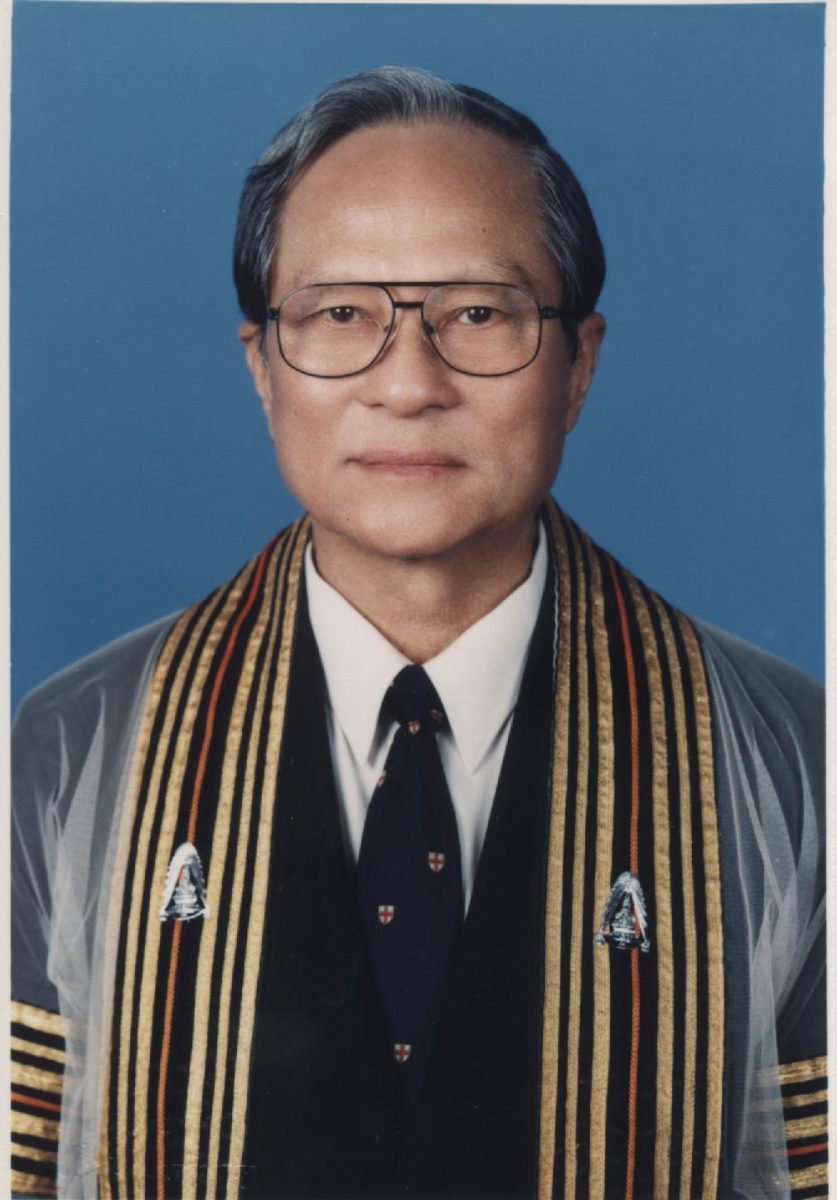
ในปีพ.ศ. ๒๕๐๔ อาจารย์สมัย ชินะผา ได้เริ่มก่อตั้งสถานศึกษาที่ให้ชื่อว่า โรงเรียนเซนต์จอห์น กรุงเทพมหานคร และต่อมายังได้ก่อตั้งโรงเรียนเซนต์จอห์น Commerce (ตรีนิติ) โรงเรียนเซนต์จอห์นพณิชยการ โรงเรียนเซนต์จอห์นเทคนิคกรุงเทพ โรงเรียนเซนต์จอห์นอาชีวะศึกษา โรงเรียนนานาชาติเซนต์จอห์น วิทยาลัยเทคโนโลยีเซนต์จอห์น และมหาวิทยาลัยเซนต์จอห์น
อาจารย์สมัย ชินะผา เป็นครูผู้เปี่ยมด้วยประสบการณ์ทางการศึกษาจากการเป็นครูและต่อมาได้รับแต่งตั้งเป็นครูใหญ่ของโรงเรียนเซนต์คาเบรียล ระหว่างที่ทำงานเป็นครู ท่านได้ศึกษาที่จุฬาลงกรณ์มหาวิทยาลัยด้วย จนที่สุดสำเร็จการศึกษาได้รับพระราชทานปริญญาครุศาสตร์บัณฑิตและอักษรศาสตร์บัณฑิต หลังจากนั้น ท่านได้รับทุนของบริติชเคาน์ซิลไปศึกษาต่อที่สถาบันศึกษาศาสตร์ มหาวิทยาลัยลอนดอน
ท่านเป็นครูที่เปี่ยมด้วยจิตวิญญาณของการเป็นครู และมีความปรารถนาที่จะให้ความช่วยเหลือเด็ก ๆ โดยเฉพาะอย่างยิ่งเด็กที่ยากไร้ให้มีโอกาสได้รับการศึกษาที่ดีอย่างที่ท่านได้รับ ในที่สุด ท่านได้ลาออกจากโรงเรียนเซนต์คาเบรียล เพื่อมาจัดตั้งโรงเรียนเซนต์จอห์นจนเจริญเติบโตเป็นโรงเรียนที่มีชื่อเสียงแห่งหนึ่งของประเทศไทย โดยจัดการศึกษาตั้งแต่ระดับชั้นอนุบาลจนถึงปริญญาเอก
ในปี พ.ศ. ๒๕๓๘ คณะซิสเตอร์อัสสัมชัญ ได้เริ่มเข้าทำงานที่โรงเรียนเซนต์จอห์น คณะซิสเตอร์อัสสัมชัญเป็นคณะนักบวชหญิงที่ก่อตั้งขึ้นที่ประเทศฝรั่งเศสโดย นักบุญ มารีย์ ยูจีนี มิเลอเรต์ เดอโบร มีกิจการของคณะอยู่ใน ๓๕ ประเทศ ใน ๔ ทวีป ซิสเตอร์อัสสัมชัญที่ทำงานในประเทศไทยมาจากประเทศฟิลิปปินส์ โดยพวกแรกเดินทางมาตามคำเชิญของพระคุณเจ้าเปโตร คาเร็ตโต แห่งสังฆมณฑลสุราษฎร์ธานีในปี พ.ศ. ๒๕๓๓
งานหลักของคณะซิสเตอร์อัสสัมชัญ ได้แก่งานด้านการศึกษาโดยทำกิจการโรงเรียน ศูนย์ฝึกอบรมเยาวชน ทั้งเด็กและผู้ใหญ่ ศูนย์พัฒนาบุคลากร ศูนย์คำสอน งานอภิบาลในโรงเรียน การเข้าเงียบ และการเจริญชีวิตฝ่ายจิต
ในประเทศฟิลิปปินส์ คณะซิสเตอร์อัสสัมชัญมีกิจการโรงเรียนของตนเองอยู่ทั่วประเทศ รวมทั้งช่วยดูแลกิจการโรงเรียนของโบสถ์และสังฆมณฑลอีกด้วย คณะซิสเตอร์ยังได้ทำงานร่วมกับคณะนักบวชอื่น ๆ เช่นคณะเยซุอิตในมหาวิทยาลัย ผู้เข้ารับการศึกษาจากคณะซิสเตอร์มาจากสถานะต่างๆ ในสังคม ในขณะที่เด็กที่มาเรียนหลายคนมาจากครอบครัวที่มีฐานะทางเศรษฐกิจดี ซิสเตอร์ก็ได้ช่วยให้การศึกษาแก่เด็กที่ยากจนจำนวนมาก เช่น เด็กยากไร้ในสลัม และเด็กยากจนในชนบทด้วย
ในปี พ.ศ. ๒๕๔๐ ได้มีการจัดประชุมใหญ่ทางการศึกษาของคณะซิสเตอร์อัสสัมชัญในเอเชีย โดยจัดขึ้นที่กรุงมะนิลา ประเทศฟิลิปปินส์ ได้มีผู้เข้าร่วมประชุมของคณะจากญี่ปุ่น อินเดีย ไทย และฟิลิปปินส์ เพื่อประเมินประสบการณ์ด้านการศึกษา ไตร่ตรอง และวางแผนสำหรับอนาคต ผู้แทนจากประเทศไทย มี ๓ ท่าน ได้แก่ ซิสเตอร์ ๒ ท่าน และอาจารย์ชัยณรงค์ มนเทียรวิเชียรฉาย ผู้อำนวยการของกลุ่มสถานศึกษาเชนต์จอห์นในขณะนั้น
ในระหว่างการประชุมครั้งนี้เอง ขณะที่ได้ไปเยี่ยมชมโรงเรียนต่าง ๆ ของคณะซิสเตอร์อัสสัมชัญในฟิลิปปินส์ อาจารย์ชัยณรงค์ ได้เกิดความคิดที่จะทำโรงเรียนเช่นเดียวกับที่ได้ไปเห็นที่โรงเรียนอัสสุมตา เมืองปัมปังกา โรงเรียนอัสสุมตาเป็นโรงเรียนที่บรรดาศิษย์เก่าของอัสสัมชัญในกรุงมะนิลาได้ช่วยกันจัดตั้งขึ้นเพื่อช่วยเหลือเด็กชาวไร่ชาวนาในเมืองปัมปังกาที่ยากจนจะได้ไม่ต้องลำบากเดินทางจากหมู่บ้านของตนเพื่อไปเรียนระดับมัธยมที่อื่น
เมื่ออาจารย์ชัยณรงค์เดินทางกลับประเทศไทยก็ได้เล่าประสบการณ์ที่ได้พบเห็นให้แก่คณะกรรมการอำนวยการของโรงเรียนเซนต์จอห์น และเสนอความคิดให้เซนต์จอห์นจัดตั้งโรงเรียนลักษณะเดียวกับอัสสุมตาขึ้นในประเทศไทย เป็นการขอบคุณพระเจ้าโอกาสปึปีติมหาการุณย์ ค.ศ. ๒๐๐๐ คณะกรรมการฯ ของโรงเรียนได้ให้ความเห็นชอบ ปัญหาใหญ่อยู่ที่ว่าโรงเรียนลักษณะเช่นอัสสุมมตา ควรจัดตั้ง ณ ที่ใด
คณะกรรมการฯ ได้มอบหมายให้อาจารย์ชัยณรงค์เป็นผู้รับผิดชอบโครงการนี้โดยได้ติดต่อสอบถามไปยังสังฆมณฑลต่าง ๆ ในประเทศไทย เพื่อขอคำแนะนำเรื่องสถานที่จัดตั้งโรงเรียนสำหรับเด็กในชนบท และได้เดินทางไปดูสถานที่ในจังหวัดต่าง ๆ ทั้งในภาคกลาง ภาคเหนือ และภาคตะวันออกเฉียงเหนือ
วันหนึ่งในขณะที่ประชุมอยู่กับพระคุณเจ้า ยอด พิมพิสาร มุขนายกแห่งสังฆมณฑลอุดรธานี จึงได้เอ่ยถึงโครงการดังกล่าว พระคุณเจ้ายอดจึงแจ้งให้ทราบว่า น่าจะมีสองแห่งที่เหมาะสม คือที่อำเภอชุมแพ จังหวัดขอนแก่น และที่หมู่บ้านท่าบม อ.เชียงคาน จังหวัดเลย ที่น่าสังเกตได้แก่ บ้านท่าบม มีโรงเรียนอนุบาลและประถมของสังฆมณฑลอยู่แล้ว แต่ยังไม่มีโรงเรียนมัธยมสำหรับเด็ก ๆ ในหมู่บ้าน ไม่นานหลังจากนั้น อาจารย์ชัยณรงค์ได้เดินทางไปสำรวจหมู่บ้านท่าบม และเห็นว่าน่าจะเป็นหมู่บ้านแห่งนี้ ในการเดินทางครั้งต่อมา อาจารย์ได้เชิญคณะซิสเตอร์อัสสัมชัญไห้ร่วมเดินทางไปด้วยเพื่อดูความเป็นไปได้ว่า ซิสเตอร์จะสามารถมาช่วยงานโดยมาอยู่ในหมู่บ้านแห่งนี้ และช่วยจัดการศึกษาตามโครงการดังกล่าวได้หรือไม่
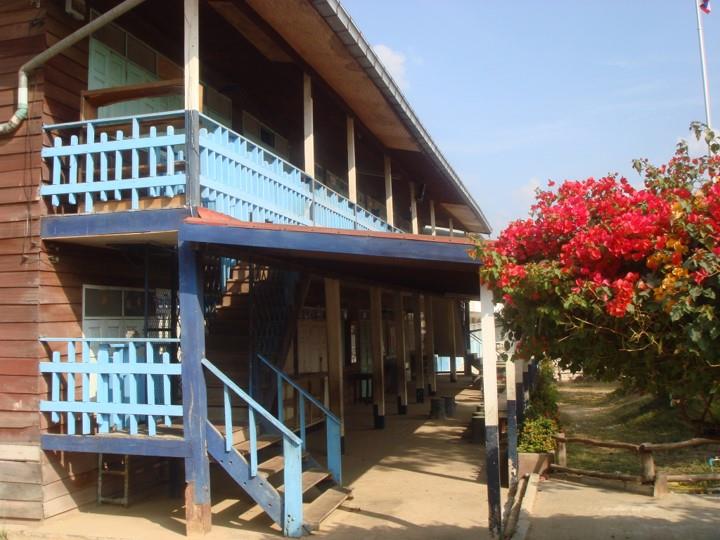
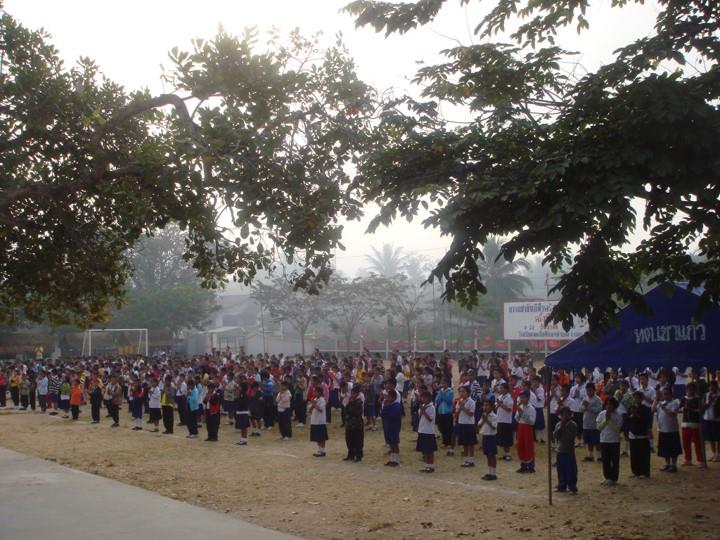
ได้มีซิสเตอร์ ๓ ท่านเดินทางมาด้วยกันและพบกับบาทหลวงบัวทอง บุญทอด เจ้าอาวาสในขณะนั้น และบรรดาผู้ใหญ่ในหมู่บ้าน หลังจากได้เดินทางมาเยี่ยมเยียนอีกหลายครั้งพร้อมกับผู้บริหารและครูของเซนต์จอห์น บรรดาซิสเตอร์อัสสัมชัญตลอดจนเพื่อน ๆ ของคณะต่างก็ให้ความสนใจหมู่บ้านแห่งนี้
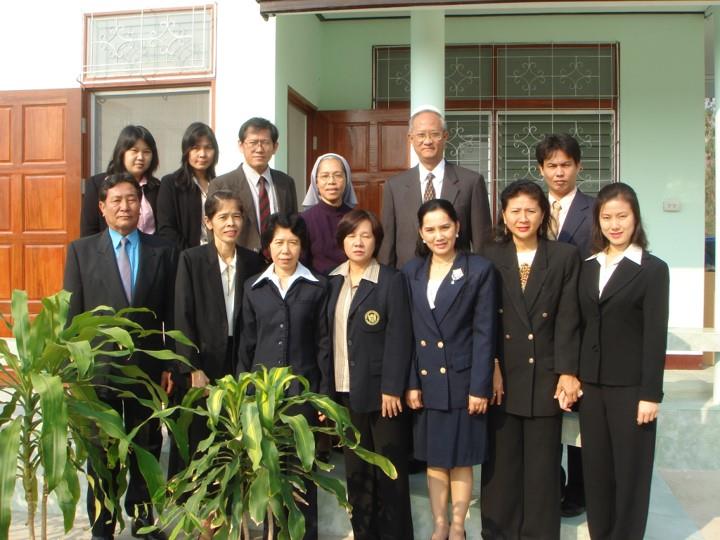
เดือนพฤษภาคม พ.ศ. ๒๕๔๑ มหาธิการิณีร่วมกับคณะที่ปรึกษา ณ ศูนย์กลางของคณะซิสเตอร์อัสสัมชัญในกรุงปารีส ได้ให้การอนุมัติให้คณะซิสเตอร์ที่กรุงเทพมหานครเปิดบ้านใหม่เพิ่มได้อีกหนึ่งแห่งที่หมู่บ้านท่าบม และอนุมัติให้สามารถทำงานกับเซนต์จอห์นในโครงการโรงเรียนนี้ได้ เริ่มต้นด้วยการช่วยบริหารจัดการโรงเรียนมหาไถ่ศึกษาท่าบม ซึ่งมีการเรียนการสอนในระดับอนุบาลและประถมอยู่แล้ว โดยมีซิสเตอร์ดีน่า มารีอา คอมบอง เป็นอธิการคนแรก
เริ่มเปิดทำการเรียนการสอนระดับมัธยมต้นในปีการศึกษา ๒๕๔๕ โดยขยายจากระดับประถมศึกษาที่มีอยู่แล้วในโรงเรียนมหาไถ่ศึกษาท่าบม มีซิสเตอร์ ๓ ท่าน ช่วยทำงานด้านงานบริหาร งานธุรการ และการเรียนการสอนร่วมกับคณะผู้บริหารของโรงเรียนมหาไถ่ศึกษาท่าบม .มีบัญชีการเงินแยกเป็นอิสระ ได้มีการขยายชั้นเรียนระดับมัธยมเพิ่มขึ้นปีละชั้นเรื่อยมาตามลำดับ ซิสเตอร์ทั้ง ๓ ท่านทำหน้าที่ดูแลแผนกมัธยมเต๊มเวลา และช่วยสอนภาษาอังกฤษ โดยยังให้ความสำคัญด้านการอบรมสั่งสอนนักเรียน และจัดอบรมครูทั้งระดับอนุบาล-ประถม-มัธยมเป็นประจำ ทั้งด้านวิชาการและจิตตารมณ์การเป็นครูอยู่เช่นเดิม
ในขณะเดียวกัน อาจารย์ชัยณรงค์ก็เริ่มมองหาสถานที่ในบ้านท่าบมเพื่อที่จะสร้างโรงเรียนมัธยม โดยการติดต่อขอซื้อที่ดินจากชาวบ้าน ซึ่งอยู่กระจัดกระจายหลายแปลง จนที่สุดได้รวมแล้วกว่าสามสิบไร่ ทั้งที่มีเอกสารสิทธิ์และไม่มีเอกสารใดๆ หลังจากนั้น ได้ติดต่อขอให้สำนักงานที่ดินจังหวัดเลยมาทำรังวัดและออกโฉนดให้ถูกต้อง ซึ่งมีขั้นตอนมากมาย ใช้เวลาทั้งสิ้นรวมแล้วประมาณห้าปี
จนในที่สุดได้เริ่มทำการก่อสร้างอาคารเรียนระดับมัธยมขึ้นในที่ดินที่อยู่เยื้องกับโรงเรียนมหาไถ่ศึกษาท่าบม เป็นอาคารคอนกรีตเสริมเหล็ก ๓ ชั้น เริ่มก่อสร้างเดือนกุมภาพันธ์ พ.ศ. ๒๕๔๖ ครั้นเมื่อก่อสร้างเสร็จเรียบร้อย จึงได้แยกแผนกมัธยมออกมาจากโรงเรียนมหาไถ่ศึกษาท่าบม และตั้งชื่อโรงเรียนใหม่ว่า โรงเรียนเซนต์จอห์นท่าบม เมื่อปีการศึกษา ๒๕๕๐ ต่อมาในปีการศึกษา ๒๕๕๑ ได้เปิดการศึกษาระดับมัธยมปลายสายศิลป์คำนวณและศิลป์ภาษาอังกฤษ หลังจากนั้นได้เปิดสายวิทยาศสตร์เพิ่มขึ้นอีกด้วยเพื่อตอบสนองความต้องการของผู้เรียนและผู้ปกครอง
ปีการศึกษา ๒๕๕๓ นักเรียนชั้นมัธยมศึกษาปีที่ ๖ รุ่นแรก สำเร็จการศึกษา
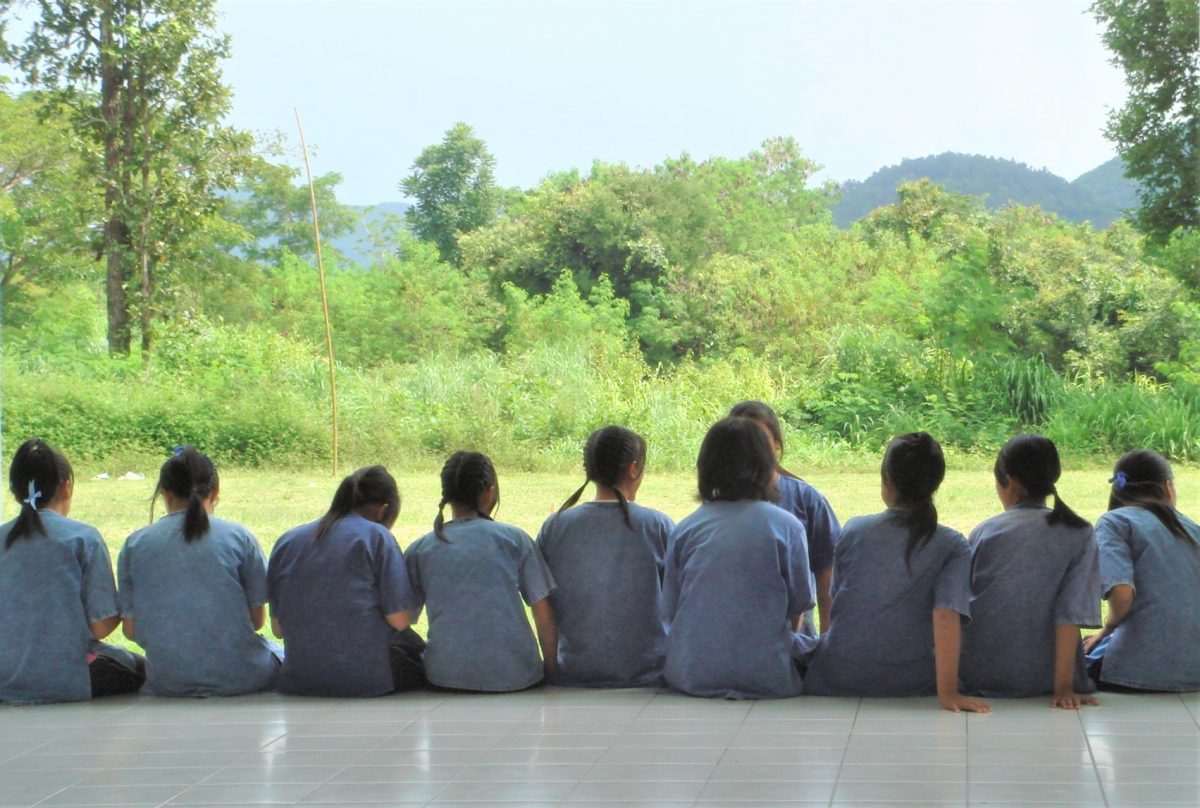
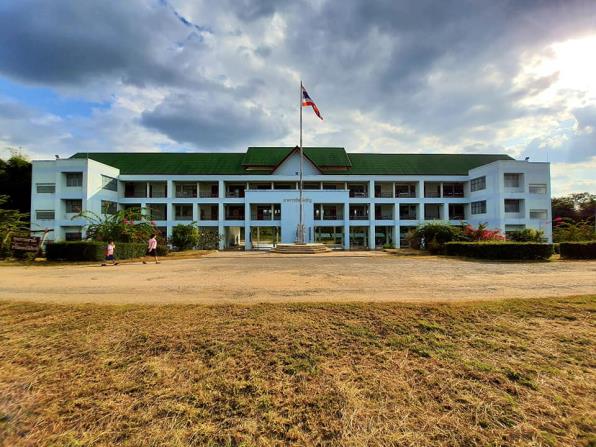
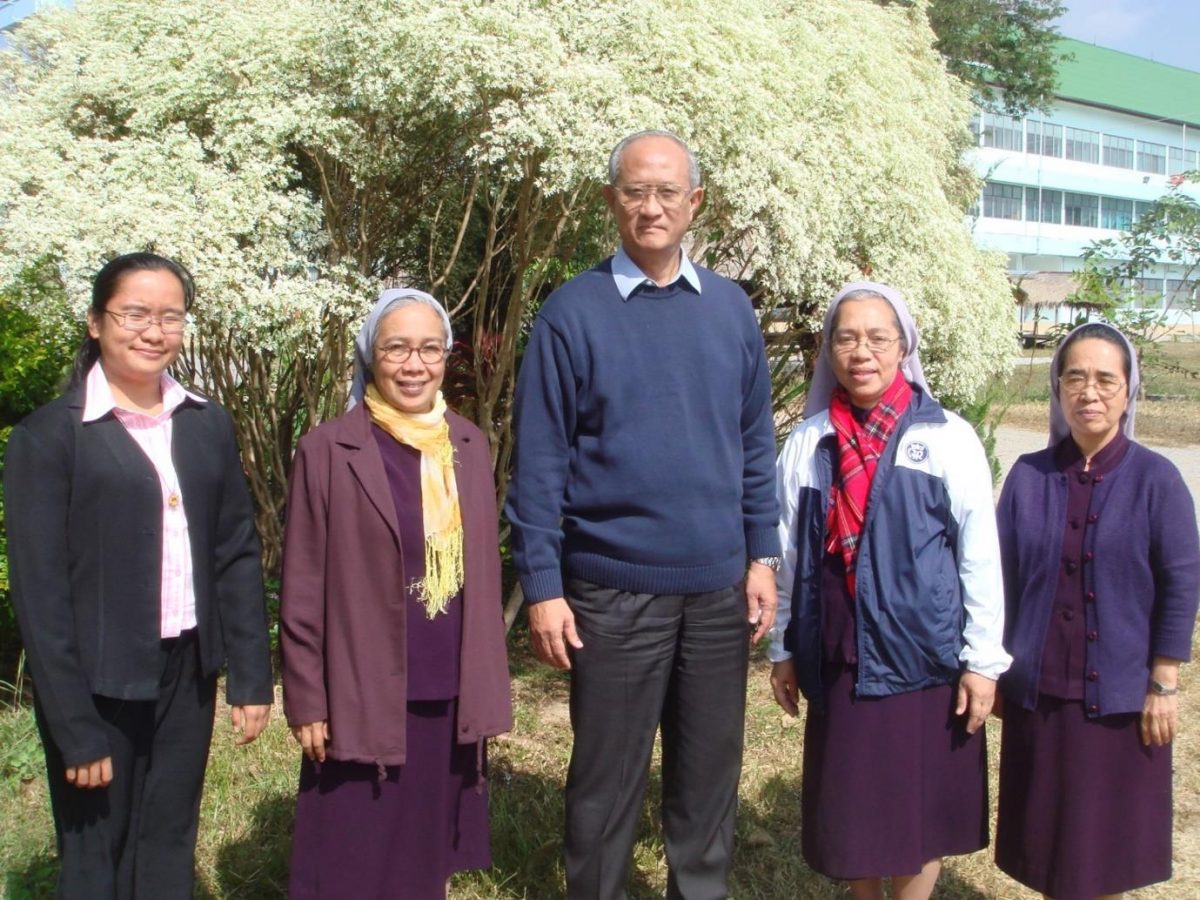
โรงเรียนเซนต์จอห์นท่าบม เปิดรับนักเรียนชาย-หญิง ไป-กลับ จัดการเรียนการสอนตั้งแต่ระดับมัธยมศึกษาปีที่หนึ่งถึงมัธยมศึกษาปีที่หก จัดการศึกษาตามพระราชบัญญัติการศึกษาแห่งชาติ พุทธศักราช ๒๕๔๒ และแก้ไขเพิ่มเติม (ฉบับที่ ๒ ) พุทธศักราช ๒๕๔๕ และหลักสูตรการศึกษาขั้นพื้นฐาน พุทธศักราช ๒๕๕๑ หลักสูตรท้องถิ่น โดยเน้นผู้เรียนเป็นสำคัญ ใช้กฎ ระเบียบ ข้อกำหนด ตามระเบียบสำนักงานคณะกรรมการการศึกษาเอกชน กระทรวงศึกษาธิการ ยึดถือพระราชบัญญัติการศึกษาโรงเรียนเอกชน พ.ศ. ๒๕๕๐ เป็นแนวปฏิบัติในการจัดการศึกษา
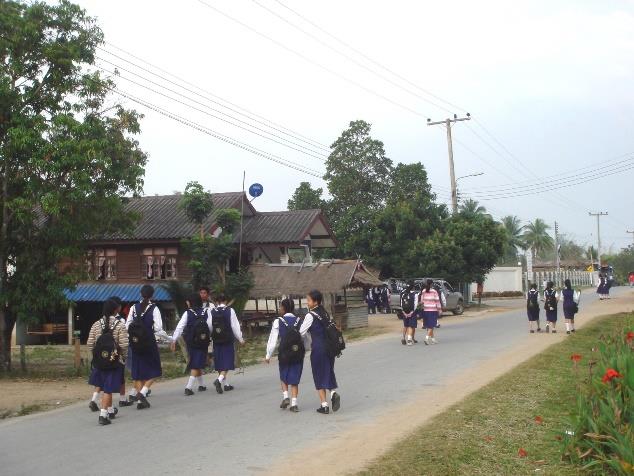
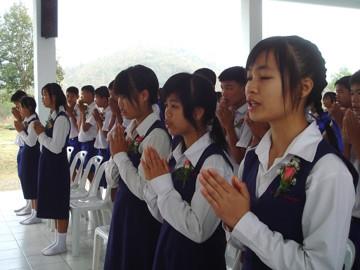
ปัจจุบัน (ปีการศึกษา ๒๕๖๔) ซิสเตอร์ดีน่า มาเรีย วี คอมบอง เป็นอธิการิณีโรงเรียน ซิสเตอร์โซเลดีเนีย เดเวรา ดูแลบัญชีและการเงิน นางกาญจน์ณัฏฐา ศิริเพ็ญ เป็นผู้อำนวยการ มีคณะซิสเตอร์อัสสัมชัญ ๕ คน ครูหญิงจำนวน ๘ คน ครูชายจำนวน ๔ คน บุคลากรทางการศึกษา ๒ คน เจ้าหน้าที่ ๑ คน ภารโรง ๑ คน แม่ครัว ๒ คน รวมบุคลากรจำนวนทั้งสิ้น ๒๓ คน จำนวน นักเรียน ๒๐๒ คน
ปรัชญาของการให้การศึกษาอบรมของคณะอัสสัมชัญที่โรงเรียนเซนต์จอห์นท่าบม ได้แก่ การศึกษาเพื่อให้เกิดการพัฒนาและการเปลี่ยนแปลงในตัวผู้เรียนเพื่อจะได้ช่วยพัฒนาและเปลี่ยนแปลงสังคมที่ดีในวันข้างหน้า การศึกษายังเป็นกระบวนการ “การปลดปล่อยให้ความดีงามซึ่งมีอยู่ในผู้เรียนแต่ละคนได้ทะลุจากหินที่ห่อหุ้มเขาอยู่ ออกมาสู่แสงสว่าง ช่วยให้ความดีงามในตัวผู้เรียนสามารถผลิดอกออกผล และฉายแสงสู่ทุกคนได้”
เพื่อจะทำเช่นนั้นได้ผู้สอนจำเป็นต้องให้การดูแลเอาใจใส่เด็กแต่ละคนเป็นอย่างดี และมองเห็นนักเรียนในฐานะปัจเจกบุคคลที่แต่ละคนไม่เหมือนกัน มีความแตกต่าง และรอคอยการพัฒนาที่ไม่จำเป็นต้องเหมือนกันหมด นักเรียนเป็นบุคคลที่พระเจ้าทรงรัก เป็นบุคคลที่มีคุณค่าและแต่ละมีศักดิ์ศรีของความเป็นมนุษย์ ในขณะเดียวกันผู้สอนจำต้องได้รับการอบรมอย่างต่อเนื่องเกี่ยวกับจิตวิญญาณของการเป็นครู รับรู้ความสำคัญถึงบทบาทในฐานะที่เป็นผู้ให้การศึกษาและเป็นตัวอย่างที่ดีงามแก่ผู้เรียน คุณครูทุกคนในโรงเรียนจำต้องตระหนักว่า หน้าที่สำคัญของตนคือการให้วิชาความรู้อย่างสุดความสามารถแก่ผู้เรียน สั่งสอนอบรมจนนักเรียนได้รับการพัฒนาอย่างสมบูรณ์ เป็นผู้มีความภูมิใจในตนเอง ภูมิใจในความเป็นคนไทย มีความรักในวัฒนธรรมไทยและเพื่อนคนไทยด้วยกัน สามารถกระทำในส่วนของตนในการช่วยสร้างชุมชนของความเป็นพี่น้องที่เปี่ยมด้วยความรัก ความเอื้ออาทร และช่วยเหลือกันและกัน ในเวลาเดียวกันก็พร้อมเปิดตนเองสู่โลกภายนอก สามารถชื่นชมวัฒนธรรมที่แตกต่าง เจริญชีวิตและทำงานร่วมกันกับผู้อื่นได้อย่างสันติ รักความยุติธรรม สามารถอยู่ร่วมกับผู้อื่นด้วยความสมานฉันท์ อีกทั้งเป็นส่วนหนึ่งที่สำคัญในการช่วยให้สังคมโลกเปี่ยมด้วยมนุษยชาติที่พึงปราถนา
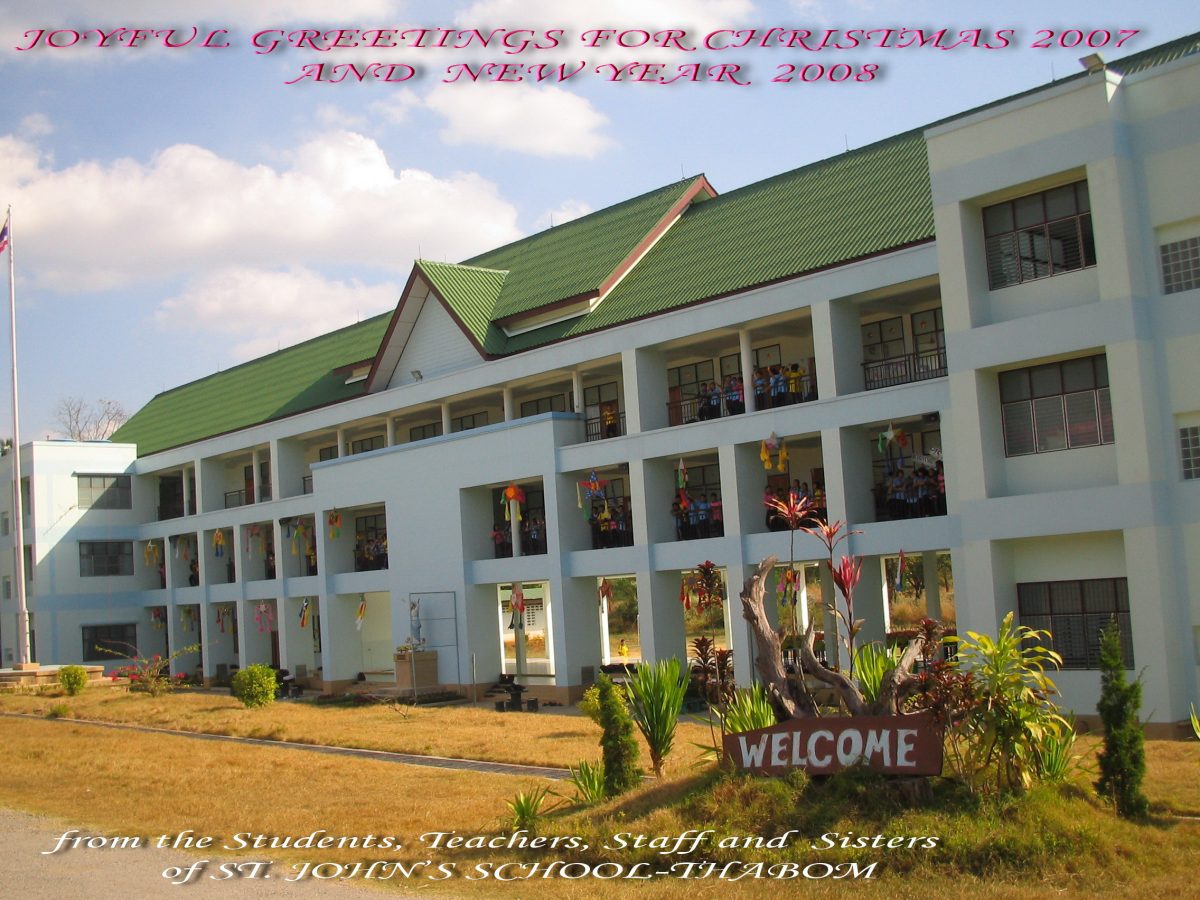
ST. JOHN SCHOOL-THABOM
The Educational Project in Thabom Village in the northeast of Thailand is a partnership between the Assumption Sisters and St. John’s School in Bangkok. Inspired by his experience during the 1997 Asian Educators’ Congress in Antipolo, Philippines which corresponded with St. John’s long-nourished dream of a school of the less privileged, Ajan Chainarong Monthienvichienchai lost no time in obtaining the St. John’s Board approval to establish the school of their dreams. The search for the place and the community culminated in Thabom Village in the Diocese of Udonthani. But this project could only be possible if the Assumption Sisters partnered with St. John’s. This, too, corresponded with the Assumption Sisters’ search for another mission after discerning and finally closing their community in the south.
The Thabom foundation was approved by the General Council in 1998. St. John’s wanted the Educational Partnership as their Millenium act, but it was not until May 2002 that the Sisters established a Community in Thabom and received 70 First Year high school students for that school year.
St. John’s High School started as the extension of the existing diocesan grade school (Mahathai Suksa-Thabom). It was sowing time for the community, a time for immersion and dialogue of life with the people in the village and the existing educational community of Mahathai Suksa –Thabom. One year level was added the next year and on the third year of their presence in Thabom, the Sisters and the students moved to the newly-built school building across the road. On its fourth year, the Ministry of Education granted the high school a separate status with its own name – St. John’s School -Thabom .
That same year the Bishop of Udonthani requested St. John’s to administer the existing diocesan Kindergarten and Grade School. After a discernment process with the community and with the approval of their Superiors, the Assumption Sisters undertook the administration and animation of the diocesan school as an expansion of their mission of education. They saw it as a timely opportunity to share the charism of education of the Congregation on a wider and deeper level. Three critical areas were attended to – the formation of the faculty and staff, the improvement of school facilities to create a more conducive atmosphere for learning, and the financial system which was needed to support the school programs.
After 8 years, the Diocesan Grade School was ready to be administered on their own and we concentrated on the high school level which now consisted of a Junior high school (M.1, 2, 3) and a Senior high school (M. 4, 5, 6)
St. John’s provided not only the land and the building for the High School which was called Assumption Building, but also the human resources to form the faculty and staff. During the initial years of operation, groups of administrators and teachers from St. John’s Bangkok, not to mention A. Chainarong himself, came regularly to give seminars on strategic planning and other academic systems. Technical staff from St. John’s came regularly to set up a computer laboratory and follow up operations. Formation of faculty and staff was on-going.
Assumption not only fielded the Sisters for the Thabom mission, but also provided other means of support and encouragement- the San Lorenzo teachers, students and alumnae came for a summer workshops in English. Associate Missionaries of the Assumption (AMA) came to stay longer (1 year to 3 years) as volunteer English teachers. Financial assistance was also granted for the school’s urgent needs and for faculty development
For a number of years, British students on their Gap Year from Ampleforth College in England came as volunteers to help teach English.
David Barraclough, another British volunteer came for some years and before leaving helped raise scholarship funds for students.
LEARN EDUCATION was set up through the initiative and contacts of A. Chainarong. This has greatly upgraded the school’s Math and Science programs.
Chainarong also connected us with Suteesak Pakdeeteva “Master Joe” and his talented team whose visits enlivened our school community with their music sessions and their friendship.
In this work of transformative education the lay faculty and staff are our closest partners. There is an equal percentage of Buddhist and Catholic teachers and personnel. Only 10 per cent of the student population is Catholic but when there are religious activities such as Masses and feasts, celebration of Assumption Day and Christmas, everyone is involved. In the same manner, the whole school supports and participates in big Buddhist feasts and activities. The parents whom we formally meet twice a year are very cooperative and our School Board is made up of both Catholic and Buddhist parents and officials.
This partnership contributed to the growth and development of the Assumption charism. The experience has strengthened our faith in God who is so present in this rural out-of-the-way place where we can almost touch Him in nature around us, in the simplicity of life and poverty of the people and of our own students who choose to study with us in spite of distance and at great sacrifices on the part of their parents.
Our mission in Thabom is an experience of the incarnation, particularly that of inclusion. While we often think of breaking (our) barriers to welcome and include others, our experience is the other way round. We feel it is we, the Sisters, a religious Community that has been welcomed, included by a people and a culture. While we are convinced that we have something to give or share, it is we who are continually receiving and to the measure that that we keep our minds and hearts open. We have given importance to the person and dignity of each one especially the materially poor among our students, and our cooks and janitors who in the past have felt out of the circle of teachers and other personnel. We have also given them a more just wage for the service they render. Compassion, Truth, pardon, love without conditions are lessons to learn in the ordinary circumstances of everyday life. Most of all we experience the power of the Gospel, of prayer- personal and communitarian – which we call the poor and powerless means of Jesus Christ.
Our community had chosen one strategic direction: “to create spaces for dialogue where “what is different is welcomed and placed at the service of life”.
Among our teachers was a former Buddhist monk. To start off the week, we would gather the school community in assembly, and he would lead the students and faculty to quiet down and to be in touch with their inner selves. The students and teachers, mostly Buddhists and a few Catholics readily enter into this silence and bodily quiet. After some moments a passage from the Gospel is read. One feels the Word of God landing on very fertile soil, prepared by the silence using the Buddhist way of quieting down facilitated by this teacher. The learning for us is that our differences in religion could be a help rather than a hindrance in our work of transformation. We only need acknowledge each other’s presence and values and gifts and put these at the “service of life”
The Assumption charism is founded on the Truth that is Jesus Christ, on the love that moves one to serve without limits, without conditions, and especially to serve the less privileged. Teamwork, being a community-person, humble collaboration are very much part of the Assumption spirit. Recognizing, giving opportunities to develop what the other has to offer is just as important as giving what one has to give; welcoming the other with his/her particular gifts and differences is “allowing the good in that person to break through the rock… and bringing it to the light where it can shed its radiance.” In the process, we are all transformed.
What transformation has taken place?
We have become more welcoming of persons as they are, not as we would rather have them be, welcoming what is different as something that we can learn from and enrich us, becoming more appreciative of persons, of another culture, of other traditions, of other ways of doing things, that we can be ONE through our differences. We trust more in the power of THE WORD to touch hearts and lives, we believe in the presence of the Spirit in the hearts of those we speak the WORD to. We are taught to be humbler in relating with others in everyday life, be more positive in language, gestures, actions. Hope is constantly renewed in daily contact with the young – hope that change, transformation is possible if we have a bit more patience, and more love which alone transforms. Experience teaches us that working with others expands our hearts and our minds to the dimensions of the world and beyond our own limits.
From the time we started this educational project, we were consciously building up a culture of peace, of sharing, of respect and dignity, of nurturing what is best in the Thai culture and traditions as well as openness to the dimensions of the world.
On Orientation Day as each school year opens, we introduce all teachers and staff, making everyone sit in front of the students. The first time we did this, some teachers asked, “also the cooks and janitors??” Thai culture is strongly hierarchical. Our response: In the Kingdom of God, everyone sits at the same table.
At the end of each semester and before we go on vacation before New Year holidays, we gather together so all teachers and staff give a blessing to the students. By now, the students look forward to this ritual, not wanting to miss it. The blessing of elders, especially in rural areas, is very meaningful for the Thai people. Mass media bringing in strong western influences has led the younger generation to neglect many of their beautiful cultural traditions. The young have responded positively to our efforts to uphold meaningful cultural practices – Mother’s Day, Father’s Day, Teachers’ Day, Loy Krathong and others. They express greater appreciation, pride and love for their own traditions, music, art. And as a providential turn of events, the Thai government has strongly advocated the implementation – at all levels, especially in education – of programs re-inculcating “12 Thai Values”.
Since the beginning, we have set aside a time for “WORLD PEACE DAY” activities. Starting off from the 9/11 event we have inculcated each one’s share in peacebuilding. Students and teachers work together to know something about the countries of the world, what ‘peace’ might mean in our own local situation, peacebuilders and keepers of peace and how each one can be an instrument of peace. A particular theme is chosen every year and last year, a Pandemic year we chose as theme – FRONTLINERS- INSTRUMENTS OF PEACE. Students and teachers dressed as doctors, nurses, health workers, service providers, peacekeepers.
Where is this experience leading us?
We are challenged to go deeper into knowing and appreciating and allowing ourselves to be transformed by what is good and beautiful and true in another culture. At the same time, we feel just as challenged to really know and live our own charism of transformative education so that our Thai lay partners and the young will own it and express it in their own Thai way, making our Assumption charism so much the richer and more beautiful and much more effective as a transformative process for persons and communities. It demands of us strong faith and a humble stance at all times.
We are on our 19th year of presence in Thabom. The school population has been fluctuating the past years for different reasons. Our trained teachers move on to government schools who pay much higher salary scales and give benefits which we cannot afford.
This year despite the Covid-19 pandemic we have a slight increase of enrolment, an encouragement we need. Our students come from 46 villages, some of them paying transportation costs higher than their tuition fees.
The Provincial Authority has come to our assistance financially with grants for the living allowance of our teachers and staff and a share in the transportation fees of students.
With the surge in Covid-19 cases and its variants in the country and in our particular region, classes onsite have become online, with our administration and faculty seeking creative ways available and workable for students in the outlying areas. Learning goes on.
The Catholic Education Council of Thailand organized a ZOOM Conference recently on the Holy Father’s call to everyone to be partners with him in the Global Compact on Education. We are fortunate to find elements of our own charism of transformative education in the principles outlined by Pope Francis. We are fortunate as well to be partners with St. John’s in the person of A. Chainarong Monthienvichienchai who is the main resource person in this Conference and takes on an active role in the on –going project of Catholic Education in Thailand.
Prepared by Sr. Deanna Maria, r.a.
with the Assumption Community, THABOM (Academic Year 2021)






